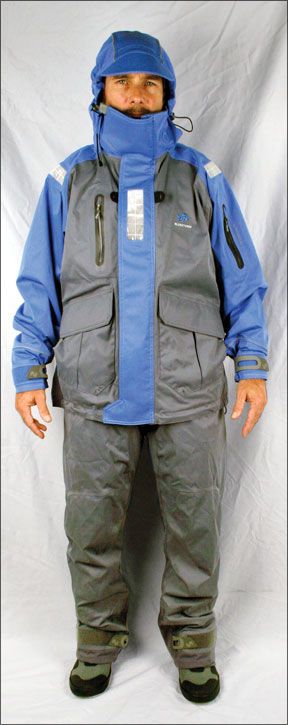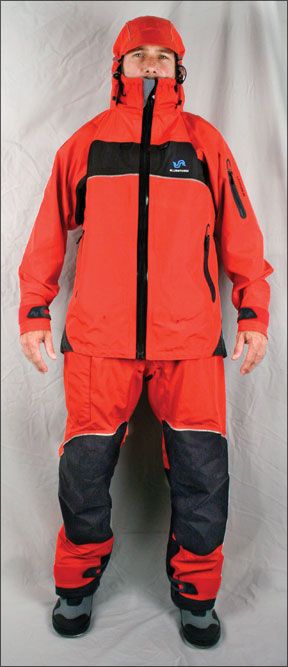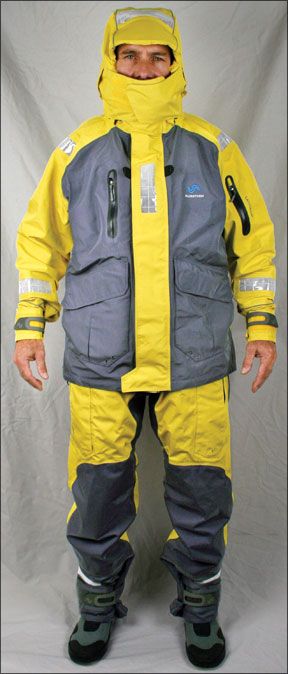The world of marine apparel is continuously evolving, following fashion trends and innovations in materials. One of the newest players to toss their hat in the apparel ring was Bluestorm. Sister company to life-jacket maker MTI Adventurewear, the Massachusetts-based Bluestorm recently launched its first line of foul-weather gear and sent Practical Sailor three mens bib-and-jacket sets to review: the Latitude 38, Latitude 48, and Latitude 61. Bluestorm named the sets for the level of performance they offer, designated by latitude-a creative and concise way for sailors to determine which set best suits their needs. Bluestorm also offers the lightweight Latitude 33 mens jacket ($180), which is good for warmer climates, and is currently working on a line of womens foul-weather gear for release next summer. Look for reviews of these in future issues.

Practical Sailor testers put the Bluestorm mens sets through their paces, comparing their performance to the Gill Key West, the top pick in our most recent evaluation of mens foulies, which was published in the February 2008 issue.
The Ideal Foulie Set
As we noted in the 2008 review, not all foul-weather gear is created equal. Sailors should look for a quality set that suits their sailing style and weather conditions, keeping in mind that proper fit is key to its effectiveness. The gear must have room enough to move and add insulating layers like a fleece when needed, but it should not be so roomy that it impedes movement or so bulky that it makes the wearer feel like the Stay Puft Marshmallow Man from “Ghostbusters.”
Above all, foulies must be dry, warm (and breathable for warmer climates), and comfortable, not to mention easy to don and doff. The bibs should have wide, easily adjustable shoulder straps. The trousers should feature abrasion-resistant padding on areas like the knees and seat, and should be adjustable at the ankles to accommodate sea boots.
The jacket should be breathable yet watertight at the neck, face, and wrists. It should have adequate reflective material in highly visible spots, such as the hood and shoulders. The brimmed hood should be a highly visible color and its peak should be semi rigid to deflect water. The hood, which must be adjustable to cinch around the wearers face, should also be easily deployed and secured.
Zippers should be high quality, made of non-corrosive, coated materials, and big enough to grasp with chilled or gloved fingers. The jacket and bibs should be high-contrast colors that are highly visible in case of a man-overboard situation. Also important are pocket design and placement; features like loops for attaching knives or for hanging the gear to dry may also be considered.
With these criteria as our guide, Practical Sailortesters tapped the Gill Key West OS5J jacket and OS5T bibs as the January 2008 Best Choice in mens foul-weather sets under $500. The Gill tested Excellent across-the-board and can be had for an affordable price. Testers especially liked the jackets hood, cozy fleece-lined neck, beefy zippers, adjustable cuffs with inner seals, and the number and type of pockets. They found the bibs rugged with thick shoulder straps and a reinforced seat and knees. The Ronstan Heavy-duty Coastal jacket and pants were named Budget Buy for their good quality and rock-bottom price.

How We Tested
Consistent with past tests, Practical Sailor evaluated each jacket-bib set on the aforementioned criteria and tested them for wind- and water-resistance, durability, and comfort.
The foulies were worn under heavy spray from a hose. Spray was directed at zippers, wrist closures, ankle closures, and around the hood area. Testers also wore them in heavy tropical rain and examined them for leaks.
The gear was tested, wet and dry, in controlled, simulated wind speeds of 15 and 20-plus knots. Testers spray-tested and wind-tested the gear with and without clothes underneath.
To determine the durability of the zippers and Velcro closures-often the first failure points in apparel-testers operated all many times. Testers noted the placement and amount of reflective material but did not perform any in-water or after-dark tests.
What We Found
All three bibs had wide, Velcro-adjusted suspenders. The Latitude 38 and Latitude 61 sets featured beefy two-way, corrosion-resistant zippers that were easy to grab with cold or gloved hands. All sets were comfortable, but the 38 was the most supple. Overall breathability varied.
Both the 38 and 48 jackets come in blue and gray or flame red and gray. The 61 comes in bright yellow. Testers prefer the high-visibility color palettes of the red or yellow sets. Camouflage blue-gray or similar palettes should be banned from sailing foul-weather gear, in our opinion.
Small details testers particularly liked were the triple-closure system for jacket storm flaps and recessed Velcro fasteners. Both the 38 and 61 jackets have Velcro, snaps and zippers. And rather than having strips or circles of Velcro sewn on top of the fabric, Bluestorm encases it in the material so that there are no raised edges to be pulled or worn.
Latitude 38
The Latitude 38 jacket and bibs are intended for use around-wait for it-latitude 38. San Francisco on the West Coast and the Carolinas on the East Coast, for example, see the conditions typical of what the Latitude 38 was designed for: cold but not extreme weather with cold rain and rough seas likely. This is the level of protection most sailors would consider for near-shore cruising.
Testers found the jacket and bibs to be supple, highly breathable, and comfortable. They proved to be fairly water- and wind-resistant during tests, thanks in part to the liner that keeps moisture away from wearers skin. Drain holes along the leg bottoms keep any errant splashes from puddling and allow the bibs to dry faster.
The jacket is adjustable at the waist and bottom, which falls below the hips and the seat. It has reflective patches on the chest and shoulders and reflective piping on the wrists and hood.

The hood has multiple toggle adjusters-one at the crown of the head, one on the back of the neck, and one on both sides of the neck front-that enable a close fit. The hood can also be cinched around the face.
The bibs have a gathered, elastic waist and a storm flap with a reflective patch over the zipper. They also feature wide, easily adjustable (Velcro) straps, a zippered pocket at the chest, lined hand-warmer slash pockets, and anti-abrasion material at the seat and ankle but not at the shins (or on the jacket elbows). Wearers who must kneel often may find that the supple material is easily abraded.
Although the jacket did well overall in the performance evaluations, the adjustable cuffs with inner seals leaked on one tester. This is a common problem as its difficult to design a cuff that allows room for gloves but is watertight.
Another leaky spot was at the base of the two-way zipper on the bibs. Because a gap between the zipper pull and the bibs is a potential leak spot (when the bibs are worn without the jacket), a second storm flap should be added inside the zipper, in our opinion.
Bottom line: This very sharp, very comfortable lightweight set performed well and appeared to be the most versatile of the three sets tested, but the leaky zipper was a drawback.
Latitude 48
Designed for areas like Seattle and the Chesapeake Bay, the Latitude 48 jacket and bibs are a stream-lined, heavier-weight version of the Latitude 38. Designed for wetter and colder climates, the 48 lacks a liner, allowing wearers to add insulating layers without losing breathability.
Both the jacket and bib have shiny, coated, “waterproof” zippers but no storm flap. Repeated spray tests showed no leaks along the zippers. Both the jacket and bibs have taped seams and fared well in all water- and wind-resistance tests. This was the only Bluestorm set without two-way zippers.
There is one open cargo pocket on the bibs and one with a flap. The jacket hood has the same effective toggle-adjustments as the Latitude 38. Unlined jacket pockets have zip closures. The jacket has reflective piping across chest and back and along the hood, with no reflective patches. The bibs have minimal reflective piping with reinforced knees and seat. According to Bluestorm, the 48 was designed more for fishermen, who prefer the camouflage of minimal reflectivity, but sailors have taken to it due to the breathability and layering possibilities.
Bottom line: The 48 performed well and has a no-nonsense approach to mid-latitude protection, but we would like to see more reflective material.
Latitude 61
Designed for use in the Great Lakes region, Atlantic Northeast, and Alaska, the Latitude 61s taped seams and dual storm flaps offer heavy-duty wind and water resistance. Its heavier-weight fabric adds warmth without sacrificing dexterity.

A highly visible set, the 61 we tested is a glowing brilliant yellow, and the jacket has reflective patches on the hood, shoulders, chest, and wrists, and reflective piping on the wrists and hood. It is lined with heavy mesh and has a fleece-like material around the face and neck that makes for a cozy fit.
The jacket has fleece-lined slash pockets for hand warming, Velcro cargo pockets, and water-resistant zippered pockets on the sleeve and on the chest, inside and out. Like the Latitude 38, the jacket has multiple toggles, and it also has an adjustable buckle along the back of the hood that keeps the brim out of the wearers eyes.
The bibs triple-layer water protection-a storm flap over the zipper, another under it, and taped seams-kept water out despite repeated sprays and soakings.
The bibs have reflective patches on the chest and ankles and reinforced material at the knees and seat. They have a zip pocket on the chest and four leg pockets-two open pockets and two cargo pockets with Velcro flaps. The area around the pockets and the bottom of the trouser legs are reinforced for abrasion resistance, another detail testers liked.
Bottom line: Testers really liked this top-performing suit with innovative features. However, the $700 price well exceeds the $500 price point in the 2008 foul-weather gear tests, dropping the 61 out of the running.
Conclusion
Overall, Bluestorms first foray into foul-weather gear was a success, in our opinion. Some kinks remain to be sorted out (no blue for sailors, please), but we appreciate the designers attention to detail and dexterity. Were curious to see how these suits will hold up to long-term, real-world use.
The main drawback of the Latitude line is its price. The least expensive of the bunch-the Latitude 48-was the only one to meet our price point but it also was our least favorite. Of the Latitude gear, we like the Latitude 38 for coastal cruising and the 61 for anything more serious or for colder climes, but their prices hold them back. This leaves the high-quality, affordably priced Gill Key West ($339) at the head of the class for mens foul-weather gear under $500, and Ronstan ($270) maintains its Budget Buy status.








































